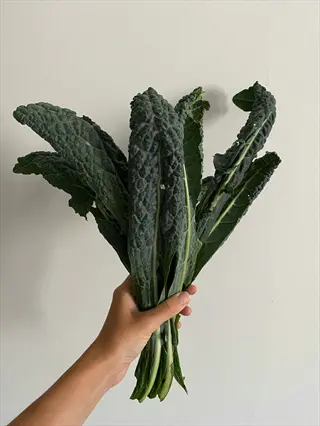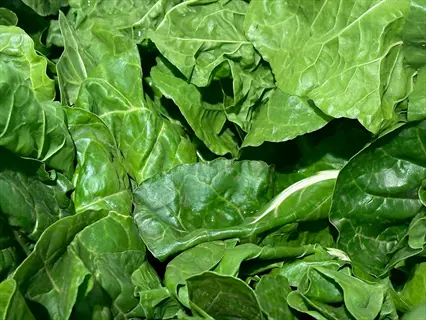10 Green Juice Benefits You Can't Ignore

Written by
Stella Nilsson
Reviewed by
Prof. Graham Pierce, Ph.D.Advantages of green juice consist of strengthening the immune system and improved hydration from said nutrients.
Making juice at home is likely to better preserve heat-sensitive nutrients than the commercially pasteurized versions.
Although short-term energy levels may increase, ingesting green juice too often may create an imbalance of nutrients over time.
If consumed, pair with foods high in protein to help slow blood sugar spikes after having it.
To help reduce the risk of kidney stones, ensure you are rotating the high oxalate greens (like spinach) for your juice as well.
To optimize antioxidant capability, use fresh ingredients and drink immediately after making.
Article Navigation
The benefits of green juice have gained significant popularity among health-conscious individuals and celebrities. Celebs like Gwyneth Paltrow often share their morning green juice routines. This drink provides a quick vehicle for nutrients from vegetables. However, remember that it supplements the diet and does not replace whole foods.
This article outlines both the honest advantages and misconceptions surrounding green juice. We will discuss how it benefits the body and address common myths that may lead to confusion. I find that others often confuse and misunderstand due to flashy claims. You require balanced facts to make informed choices.
We're providing you with useful, straightforward information. We avoid using complex scientific terms. You'll get benefits whether juicing for the first time or fine-tuning what you're already doing. You can trust that you are getting honest experience from years of nutrition work.
What Is Green Juice
Green juice is a highly nutritious drink made by juicing leafy greens, herbs, and minimal fruits. Unlike smoothies that are high in fiber, it retains primarily vitamins and minerals. Typical ingredients of green drinks are kale, spinach, celery, and green apples. They are rapidly absorbed plant foods.
Cold-pressed processing preserves nutrients better than methods using centrifugal techniques. Slow juicers do not produce heat that can destroy sensitive materials, such as vitamin C. Centrifugal juicers may work faster. Still, the nutritional compounds are oxidized, and losses of nutrients reduce responses and benefits. Homemade versions keep fresher and produce better quality than store-bought types.
Always remember that green juices are supplements to, not substitutes for, fresh vegetables. You lose a valuable part of vegetables in the juicing process - fiber, which is important in aiding digestion and regulating blood sugar. Be sure to include whole green vegetables in your meals as well, so that you receive every benefit from good nutrition. Fresh homemade juice gives you the greatest supply of enzymes and antioxidants.
For optimum results, consume the juice shortly before drinking. Oxidation starts promptly to destroy nutrients such as chlorophyll. Use organic produce to avoid concentrated pesticide residues. Simple mixtures work best, such as kale, cucumber, and lemon juice. This process yields the optimal benefits of green juice.
Definition
- Green juice is a liquid extract made primarily from green vegetables like kale, spinach, and celery
- Small amounts of low-sugar fruits like green apple or lemon are often added for palatability
- Serves as a concentrated source of vitamins, minerals, and plant compounds but lacks the fiber of whole produce
- Best consumed fresh and unpasteurized to preserve heat-sensitive nutrients like vitamin C and antioxidants
Essential Ingredients
- Leafy greens: Kale (vitamin K), spinach (iron), Swiss chard (magnesium) form the nutritional foundation
- Hydration bases: Cucumber and celery provide over 90% water content and essential electrolytes
- Herbal accents: Parsley and mint add flavor complexity while supporting digestive function
- Low-sugar fruits: Green apple and lemon contribute vitamin C and tartness without excessive sweetness
Processing Methods
- Cold-pressed (masticating): Slowly crushes produce to minimize heat/oxidation, preserving 90%+ nutrients
- Centrifugal: High-speed spinning generates heat that degrades heat-sensitive vitamins like folate and vitamin C
- Blender method: Requires straining pulp, resulting in lower yield and potential nutrient loss
- Commercial processing: Pasteurization extends shelf life but reduces bioactive compounds by 30-50%
Nutritional Profile
- Rich in vitamin A: Supports eye health and immune function with 70% Daily Value (DV) per 8 oz (240ml) serving based on a 2,000-calorie diet
- High potassium content: An 8 oz (240ml) serving provides 15% DV to regulate blood pressure and hydration
- Contains magnesium: Essential for muscle function and energy metabolism at 10% DV per serving
- Antioxidant compounds: Chlorophyll and lutein combat oxidative stress and cellular damage
Common Misconceptions
- Not equivalent to whole vegetables: Juicing removes insoluble fiber crucial for digestive health
- Not automatically low-sugar: Fruit-heavy versions can contain as much sugar as soda beverages
- Not a detox solution: Liver and kidneys naturally detoxify without juice intervention
- Not nutritionally complete: Lacks protein and healthy fats needed for balanced nutrition
Best Ingredients for Maximum Benefits
Organizing foodstuffs according to function ensures that the advantages of green juice are maximized. Leafy green vegetables, such as kale and spinach, provide the nutritional base, as well as vitamins and minerals. Hydrators, such as cucumber and celery, provide water content to balance electrolytes. Flavor enhancers, such as green apple, contribute to the taste but not the sugar.
Every component has certain nutrient characteristics. Kale contains vitamin K, which promotes blood and bone health. Spinach contains iron, which is essential for oxygen transport. Celery has natural sodium, which has a natural effect on the body. Ginger has properties that reduce inflammation. Knowing the food's characteristics will help you target the specific benefits that you want.
Oxalate levels require attention, especially in individuals with nephron-sensitive conditions. Spinach has a high oxalate content, which may contribute to the formation of stones. Safer are kale or romaine. Always rotate high-oxalate ingredients and use lemon juice to reduce the risk of crystallization.
The quality of one's ingredients has a significant impact on nutrition. Organic produce can produce stress from pesticide exposure, which is especially important with juicing because of the concentrated residue of pesticides. Wash all greens well in a baking soda solution. Remove the firm stems from vegetables before juicing to make them more palatable and nutritious.

Kale
- Rich in vitamin K: Provides 680% Daily Value (DV) based on a 2,000-calorie diet per cup (240ml) serving, supporting blood clotting and bone health
- Contains lutein and zeaxanthin: Antioxidants that protect eyes from blue light damage and reduce macular degeneration risk
- Low oxalate option: Safer than spinach for those concerned about kidney stone formation
- Preparation tip: Remove tough stems before juicing to improve texture and nutrient yield
- Organic priority: Ranked high on pesticide residue lists requiring thorough washing

Spinach
- Iron content: Provides 15% Daily Value (DV) based on a 2,000-calorie diet per cup (240ml) supporting oxygen transport
- High in magnesium: Essential mineral for muscle function and nerve transmission
- Oxalate caution: Contains 750mg per cup (240ml); limit for kidney-sensitive individuals
- Vitamin A powerhouse: Delivers 56% DV as beta-carotene for immune and vision support
- Cleaning method: Soak in baking soda solution (1 tbsp/15ml per quart/0.95L) for 15 minutes

Celery
- Hydration base: 95% water content with natural sodium for electrolyte balance
- Anti-inflammatory compounds: Contains apigenin and luteolin shown to reduce inflammation
- Low-calorie density: Adds volume with only 16 calories per cup (240ml) for weight management
- Blood pressure support: Phthalides may help relax artery walls and improve circulation
- Fiber retention tip: Juice with leaves for extra insoluble fiber content

Green Apple
- Low-sugar sweetener: Only 13g sugar per medium fruit compared to 23g in red apples
- Polyphenol source: Contains epicatechin and procyanidins that support cardiovascular health
- Enzymatic browning prevention: Add lemon juice immediately after cutting to preserve nutrients
- Pectin content: Provides soluble fiber that survives juicing to support gut health
- Selection guide: Choose firm, unbruised fruits with bright green skin for optimal freshness

Ginger
- Anti-inflammatory properties: Gingerol shown to reduce muscle pain in clinical observations
- Digestive aid: Stimulates gastric enzymes to alleviate bloating and improve nutrient absorption
- Blood sugar regulation: May improve insulin sensitivity and reduce post-meal glucose spikes
- Preparation method: Juice with skin for extra antioxidants after thorough washing
- Dosage recommendation: Limit to 1-inch (2.5cm) piece per serving to avoid heartburn
How to Make Green Juice at Home
The equipment you choose has a significant impact on the quality of your juices. Commercial juicers, especially the cold-press style, are superior as far as nutrient retention when compared to centrifugal juicers. Blenders produce juice ingredients that can be filtered with cheesecloth, but are high in pulp. Each method used has some effect on texture and nutrient retention.
Measure your ingredients accurately, and they will be perfectly balanced in terms of their nutritional value. You need 2 cups of leafy greens, such as kale or spinach, 1 1/2 cups of another food rich in hydration, like cucumber or celery, 1/2 cup of a low-sugar fruit, like a green apple, and 1 tablespoon of a food that serves as a functional booster, like ginger.
Timely preparation of juices minimizes nutrient loss. Juice should be prepared immediately before drinking to minimize oxidation. However, if you are storing it, keep it in air-tight amber glass bottles in the refrigerator. If the juice is drunk within 15 minutes, it would gain the greatest benefits from the antioxidants, oxidation quickly breaks down the vitamins.
Fix common problems easily. To separate pulp, stir or shake the juice before drinking. If foam forms, skim it off with a spoon. To prevent clogging, alternate soft and hard ingredients. Always clean equipment immediately after using.
Juicer Types
- Masticating juicers: Operate at 80 revolutions per minute for minimal oxidation preserving nutrients
- Centrifugal juicers: High-speed processing generates heat reducing nutrient retention
- Blender alternative: Requires fine-mesh strainer and retains more fiber than juicers
- Twin-gear press: Highest nutrient preservation but requires disassembly for cleaning
- Citrus attachments: Separate accessory for juicing lemons/limes without cross-contamination
Preparation Tools
- Cutting boards: Non-porous surfaces prevent bacterial absorption during prep
- Knives: Ceramic blades prevent metallic taste from oxidation with greens
- Measuring tools: Standard 8 oz (240 ml) cups with metric gradations ensure accuracy
- Storage containers: Amber glass bottles block UV light to slow nutrient degradation
- Cleaning brushes: Small bristle brushes remove pulp from juicer screens effectively
Safety Features
- Automatic shut-off: Prevents motor burnout when pulp container is full
- Non-slip bases: Rubber feet stabilize juicers during high-speed operation
- Food pushers: Safely guide ingredients without finger contact with blades
- Overload protection: Circuit breakers reset after jam clearing
- BPA-free materials: Ensure no chemical leaching into juice during processing
Maintenance Tools
- Brush sets: Specific sizes for cleaning juicer screens and crevices
- Sanitizing solutions: Food-safe hydrogen peroxide mixtures for deep cleaning
- Drying racks: Air-dry components vertically to prevent water pooling
- Replacement parts: Extra strainers and seals extend appliance lifespan
- Storage cases: Keep components organized and dust-free between uses
Accessory Options
- Pulp collectors: Separate containers capture fiber for reuse in recipes
- Foam separators: Remove froth during juicing for smoother texture
- Adjustable spouts: Control juice flow into containers of different sizes
- Travel lids: Secure sealing for transporting fresh juice safely
- Frozen fruit attachments: Special chutes for processing frozen ingredients
Ingredient Preparation
- Wash thoroughly: Soak greens 15 minutes in baking soda solution
- Chop strategically: Cut produce into uniform 1-inch (2.5 cm) pieces
- Sequence matters: Juice soft ingredients before hard produce types
- Yield optimization: Roll leafy greens into compact balls before feeding
- Temperature control: Chill ingredients before juicing for freshness
Juicing Process
- Cold-press method: Feed ingredients slowly to minimize motor strain
- Pulp management: Stop every 2 cups (480 ml) to clear pulp container
- Oxidation prevention: Add lemon juice immediately after extraction
- Temperature maintenance: Place collection cup on ice bath during juicing
- Batch processing: Juice similar-textured ingredients together
Post-Processing
- Straining: Use nut milk bag for smoothest texture with blender method
- Serving temperature: Best at 50-55°F (10-13°C) without ice dilution
- Consumption window: Drink within 15 minutes for maximum nutrients
- Storage protocol: Refrigerate in airtight containers for max 24 hours
- Pulp utilization: Save fiber for soups or baking to reduce waste
Troubleshooting
- Foam reduction: Skim surface with spoon or use fine mesh strainer
- Clog prevention: Alternate soft and hard ingredients during feeding
- Motor jams: Reverse function clears blockages without disassembly
- Separation solution: Shake well before drinking separated juices
- Bitter taste fix: Balance with cucumber or apple in next batch
Advanced Techniques
- Layering method: Create visual effects with different colored juices
- Infusions: Add herbs like mint after juicing for fresh flavor bursts
- Carbonation: Use soda charger for sparkling green juice variation
- Freezing: Pour into ice cube trays for smoothie additions later
- Fortification: Stir in chia seeds or spirulina after juicing
10 Proven Green Juice Benefits
Benefits of green juice include powerful immune system support resulting from specific physiological actions. Kale provides 120% of your daily vitamin C requirement per serving and increases the production of white blood cells. Spinach contributes zinc, which supports immune function by aiding in immune signaling. These nutrients work together to help reinforce your immune defenses against illnesses.
The electrolytes in celery are absorbed more quickly than water, leading to its hydration benefits. Ginger has anti-inflammatory properties and can lower bodily markers of inflammation. It is low in calories, averaging 45 calories per serving, to help maintain goals. The B vitamins effectively convert food into cellular energy.
Celery's nitrates relax blood vessels, which improves heart health. Kale provides UV protection and Vitamin C to support the skin's collagen. Liquid nutrients enter the system three times faster than food. These ten things make green juice a powerful nutritional supplement.
Immune System Enhancement
- Vitamin C boost: 8 oz juice provides 120% DV supporting white blood cell production
- Zinc content: Spinach contributes 10% DV per serving for immune cell signaling
- Antioxidant protection: Chlorophyll neutralizes free radicals reducing infection susceptibility
- Bioflavonoid support: Citrus compounds enhance vitamin C absorption and utilization
Enhanced Hydration
- Electrolyte profile: Celery provides sodium/potassium for optimal fluid balance
- Cellular absorption: Liquid form facilitates faster hydration than plain water
- Mineral content: Magnesium aids cellular water retention mechanisms
- Diuretic contrast: Unlike coffee, contains no compounds that increase urination
Digestive Support
- Prebiotic action: Inulin from greens feeds beneficial gut bacteria
- Enzyme stimulation: Ginger increases digestive juice production
- Motility improvement: Magnesium relaxes intestinal muscles
- Inflammation reduction: Cucumber compounds soothe digestive tract lining
Inflammation Reduction
- Antioxidant mechanism: Kale flavonoids inhibit inflammatory enzyme pathways
- Systemic impact: Bioactive compounds reduce whole-body inflammation markers
- Joint support: Gingerol may alleviate discomfort through COX-2 inhibition
- Chronic benefit: Regular consumption supports lower baseline inflammation
Weight Management
- Calorie efficiency: Average 45 calories per 8 oz replacing higher-calorie snacks
- Metabolic boost: B vitamins support energy conversion processes
- Appetite regulation: Celery compounds influence satiety hormone production
- Long-term impact: Consistent substitution supports healthy weight maintenance
Energy Elevation
- Mitochondrial support: Iron enables oxygen transport for Adenosine Triphosphate production
- Electrolyte synergy: Potassium/magnesium prevent muscle fatigue during activity
- Bioavailability advantage: Nutrients absorb efficiently from liquid form
- Vitamin activation: B-complex vitamins convert food to cellular energy
Skin Health Improvement
- Collagen synthesis: Vitamin C is essential for skin protein production
- UV protection: Lutein from kale provides natural sunlight defense
- Elasticity support: Silica in cucumbers maintains skin structural integrity
- Antioxidant defense: Neutralizes free radicals that accelerate skin aging
Cardiovascular Support
- Blood pressure regulation: Nitrates promote blood vessel relaxation
- Cholesterol management: Fiber-bound compounds reduce LDL absorption
- Homocysteine reduction: B vitamins support amino acid metabolism
- Endothelial function: Improves blood vessel flexibility and responsiveness
Muscle Recovery Acceleration
- Inflammation control: Gingerol reduces exercise-induced muscle inflammation
- Electrolyte replenishment: Replaces minerals lost through physical exertion
- Oxidative stress reduction: Antioxidants combat exercise-generated free radicals
- Repair nutrients: Magnesium supports protein synthesis pathways
Nutrient Bioavailability
- Absorption advantage: Liquid form bypasses digestive barriers for direct nutrient uptake
- Synergistic compounds: Vitamin C enhances iron absorption efficiency
- Enzyme preservation: Raw preparation maintains plant enzymes aiding digestion
- Nutrient density: Concentrated source of vitamins from multiple vegetable servings
Potential Downsides to Monitor
Diabetes necessitates blood sugar restrictions. Whole fruit juices, which contain over 15 grams of sugar in one serving, often cause spikes in blood sugar levels. Patients can avoid sugar problems by limiting themselves to four ounces of fruit juice at a time and always pairing it with protein-rich foods. Protein foods slow the absorption of sugars in juices and prevent rapid fluctuations in blood sugar levels.
Health risks to the kidneys arise from oxalates found in greens such as spinach. When consumed in excess of 1 cup per day, oxalates approach the limits of tolerance. Rotate high-oxalate ingredient greens with chlorophyll-rich foods like kale. Adding lemon juice to salads can inhibit the formation of crystals associated with kidney stones.
Without fiber, which represents 90 percent of the nutrients, the imbalance occurs. Juice lacks protein and fats, substances necessary for vitamin assimilation. Juice must be taken within half an hour after eating food, and not later, for then you receive nutrients in their complementary form, which the juice itself lacks.
Drug interactions are dangerous. Kale's high vitamin K level prevents blood thinners from working effectively. Cruciferous species avoid the absorption of thyroid drugs. If you are taking prescriptions, consult your doctor before incorporating green juices. Too much of everything is still unhealthy.
Blood Sugar Concerns
- Fruit sugar concentration: Apple-heavy juices contain 15g+ sugar per 8 oz (240ml)
- Fiber deficiency: Juicing removes insoluble fiber that normally slows glucose absorption
- Diabetic considerations: Can cause significant blood sugar spikes without protein pairing
- Mitigation: Limit fruit to 20% of recipe; pair with 15g protein like Greek yogurt
Kidney Health Risks
- Oxalate content: Spinach provides 200mg per cup (30g) - 25% of daily tolerance limit
- Mineral binding: Oxalates reduce calcium/magnesium absorption by 40-60%
- Stone formation risk: Concentrated intake may increase kidney stone susceptibility
- Mitigation: Rotate high-oxalate greens; include lemon juice to inhibit crystallization
Nutrient Imbalances
- Fiber deficiency: Juicing removes 90% of original vegetable fiber content
- Protein absence: Typical green juice contains <2g protein per serving
- Fat-soluble vitamin limitation: No fats impair absorption of vitamins A/K/E
- Mitigation: Consume within 30 minutes of whole-food meal containing fats/proteins
Medication Interactions
- Vitamin K content: Kale provides 680% DV (based on 90mcg Daily Value) per cup
- Thyroid considerations: Cruciferous vegetables contain goitrogens affecting iodine uptake
- Ginger interactions: May potentiate blood-thinning medications like warfarin
- Mitigation: Consult healthcare provider; separate juice consumption from medication
Food Safety Issues
- Pathogen risk: Unpasteurized juices may contain E.coli from contaminated produce
- Oxidation effects: Nutrient loss up to 50% occurs within 30 minutes of juicing
- Pesticide concentration: Non-organic greens contain 3-5x more residues than whole produce
- Mitigation: Use organic ingredients; consume immediately; wash with baking soda solution
5 Common Myths
Green juice detoxes and cleanses the body more effectively than your body's natural detoxification systems
The liver and kidneys naturally detoxify the body without needing juice. Green juice does not help to eliminate toxins to a greater degree than the body's organs can already do so effectively. Claims for detoxification often misconstrue the filtration mechanism of the body and can lead to potentially dangerous cleanses that deprive your body of essential nutrients.
Drinking green juice every single day is vital and necessary for obtaining optimal health benefits consistently.
If drunk every day, you can create a nutrient imbalance and introduce health risks like kidney stones due to an increase in oxalates. For this reason, nutritionists advise limiting consumption to 2-3 times weekly as a dietary supplement in a properly balanced diet, not as a meal replacement. Excessive intake of juices can create a "displacement" of proteins and fats which are necessary for body functions.
The nutritional value of drinking green juice is the same as eating whole vegetables that are intact
Juicing removes up to 90% of insoluble fiber which is essential to digestive health and blood sugar control. Without the fiber found in whole vegetables, glucose absorption is more rapid, beneficial gut bacteria starve, and there is less feeling of fullness. Also, liquid juice does not prompt the chewing mechanism which results in the secretion of digestive enzymes in the mouth and stomach.
All green drinks are low in sugar and perfectly safe for diabetics to drink as freely as they like.
The fruit-laden recipes can carry 15g.+ of sugar per serving, matching soda drinks for their sugar content. Even the vegetable only juices cause sharp spikes in glucose due to the lack of fiber, etc., which slows down the absorption of sugars. Diabetics should severely limit the portions consumed and always take some source of protein along with the juice to mitigate any fluctuations in blood sugar.
Pasteurized juices available in stores have all the health benefits and nutritional value of a fresh homemade juice.
30 to 50 percent of heat-sensitive vitamins, such as vitamin C and many antioxidants, are extem in pasteurization. The juices in cans contain preservatives and are devoid of the live, active enzymes present in fresh juice. Continued deterioration takes place in the storage of the juice so that cold-pressed homemade juice is superior from a nutritional point of view, if the juice is taken right after preparation.
Conclusion
Green juice should be used as an adjunct to whole foods, rather than as a substitute for them. It adds nutrition, not subtracts from meals. This allows for the necessary fiber and protein to be consumed. The body requires a well-rounded diet, which cannot be achieved solely from juice.
Balance and quality serve as the basis for success. Choose organic to reduce exposure to pesticides. Limit juice consumption to 2-3 times a week, resisting the temptation to drink juice daily. Adjust the recipes to suit your specific health needs and goals.
Implement these practical steps today. First, rotate greens weekly to avoid the buildup of oxalic acid. Second, pair juice with protein sources such as nuts or yogurt. Third, consume the juice within 15 minutes of making it. Fourth, consult your physician if you are taking medications.
External Sources
Frequently Asked Questions
Is daily consumption of green juice beneficial?
While green juice offers nutrients, daily consumption risks oxalate buildup and nutrient imbalances. Limit intake to 2-3 times weekly as a supplement to whole foods, not a replacement. Pair with protein sources to mitigate blood sugar spikes from natural sugars.
When is the optimal time to drink green juice?
Mid-morning or before meals enhances nutrient absorption without interfering with digestion. Avoid nighttime consumption as natural sugars may disrupt sleep. Always pair with protein if consumed alone to stabilize blood glucose levels effectively.
What ingredients should be avoided in green juice?
Limit high-sugar fruits and high-oxalate greens like spinach if kidney-sensitive. Avoid starchy vegetables and always remove fruit pits/seeds. Prioritize organic produce to minimize pesticide residues that concentrate during juicing.
Can green juice specifically reduce abdominal fat?
No juice targets fat loss, but as a low-calorie snack replacement, it supports weight management. Belly fat reduction requires overall calorie control and exercise. Green juice provides nutrients but lacks protein/fiber for sustained satiety.
What defines the healthiest green juice composition?
The healthiest juice prioritizes:
- Leafy greens (kale/spinach) for vitamins
- Low-sweetness fruits (green apple/lemon)
- Functional boosters like ginger
- Immediate consumption post-preparation
- Organic ingredients to avoid pesticides
Does green juice consumption cause kidney stones?
High-oxalate greens like spinach increase risk when consumed excessively. Rotate ingredients and add lemon juice to inhibit crystallization. Those with kidney conditions should limit to small portions of low-oxalate recipes.
How long does homemade green juice remain fresh?
Nutrient degradation begins immediately:
- Optimal: Consume within 15 minutes
- Refrigerated: Up to 24 hours in airtight amber glass
- Avoid freezing - alters texture/nutrients
- Pasteurized store juice: Follow expiration dates
Is green juice suitable for diabetic individuals?
Use extreme caution due to sugar content and rapid absorption. Limit to small portions paired with protein/fat. Monitor blood glucose and prioritize vegetable-only recipes without fruits. Always consult your healthcare provider first.
Should you drink green juice on an empty stomach?
While it maximizes nutrient absorption, empty-stomach consumption may cause discomfort. If experiencing nausea, pair with a small protein source. Those with acid sensitivity should avoid citrus-heavy juices before eating.
What drinks are most harmful for blood sugar?
The worst options include:
- Fruit-dominant juices (orange/pineapple)
- Sweetened commercial juices with added sugars
- Sodas and energy drinks
- Juices consumed without protein/fiber buffers

